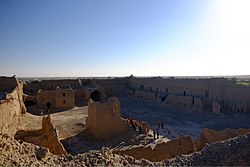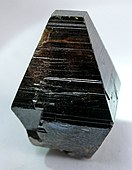Kharan District
This article possibly contains original research. (April 2016) |
Kharan District
ضلع خاران ھاران دمگ ضلع خاران | |
|---|---|
| Kharan | |
 Kharan Fort | |
 Map of Balochistan with Kharan District highlighted | |
| Country | |
| Province | |
| Division | Rakhshan |
| Established | March 15, 1952 |
| Headquarters | Kharan |
| Government | |
| • Type | District Administration |
| • Deputy Commissioner | N/A |
| • District Police Officer | N/A |
| • District Health Officer | N/A |
| Area | |
• District of Balochistan | 14,958 km2 (5,775 sq mi) |
| Population (2023)[1] | |
• District of Balochistan | 260,352 |
| • Density | 17/km2 (45/sq mi) |
| • Urban | 80,806 |
| • Rural | 179,546 |
| Time zone | UTC+5 (PST) |
| District Councils | 9 Union Councils |
| Number of Tehsils | 3 (1 Sub Tehsils |
Kharan district (Balochi: ھاران دمگ; Urdu: ضلع خاران) is a district in the Balochistan province of Pakistan.
Administration
[edit]| Tehsil | Area
(km²)[2] |
Pop.
(2023) |
Density
(ppl/km²) (2023) |
Literacy rate
(2023)[3] |
Union Councils |
|---|---|---|---|---|---|
| Kharan Tehsil | 2,941 | 104,035 | 35.37 | 48.63% | ... |
| Sar-Kharan Tehsil | 3,539 | 86,015 | 24.30 | 36.70% | ... |
| Tohumulk Tehsil | 6,347 | 49,803 | 7.85 | 34.81% | ... |
| Patkain Tehsil | 2,131 | 20,499 | 9.62 | 35.06% | ... |
Demographics
[edit]| Year | Pop. | ±% p.a. |
|---|---|---|
| 1951 | N/A | — |
| 1961 | N/A | — |
| 1972 | N/A | — |
| 1981 | N/A | — |
| 1998 | 96,900 | — |
| 2017 | 162,766 | +2.77% |
| 2023 | 260,352 | +8.14% |
| Sources:[4] | ||
Population
[edit]According to 2023 census, the district had a population of 260,352.[5]
Religion
[edit]In the 2023 census, 2,240 (1.05%) people in the district were from religious minorities, mainly Hindus.[1]
Language
[edit]At the time of the 2023 census, 91.24% of the population spoke Balochi and 8.5% Brahui as their first language.[6]
Education
[edit]According to the Pakistan District Education Rankings 2017, district Kharan is ranked at number 110 out of the 141 ranked districts in Pakistan on the education score index. This index considers learning, gender parity and retention in the district.
Literacy rate in 2014–15 of population 10 years and older in the district stands at 44% whereas for females it is only 27%.[7]
Post primary access is a major issue in the district with 78% schools being at primary level. Compare this with high schools which constitute only 8% of government schools in the district. This is also reflected in the enrolment figures for 2016–17 with 6,987 students enrolled in class 1 to 5 and only 170 students enrolled in class 9 and 10.
Gender disparity is another issue in the district. Only 26% schools in the district are girls’ schools. Access to education for girls is a major issue in the district and is also reflected in the low literacy rates for females.
Moreover, the schools in the district lack basic facilities. According to Alif Ailaan district education rankings 2017, the district is ranked at number 141 out of the 155 districts of Pakistan for primary school infrastructure. At the middle school level, it is ranked at number 126 out of the 155 districts. These rankings take into account the basic facilities available in schools including drinking water, working toilet, availability of electricity, existence of a boundary wall and general building condition. Approximately 4 out of 5 schools do not have electricity in them. 1 out 3 schools lack a toilet and 3 out of 5 do not have a boundary wall. About 1 out of 2 schools do not have clean drinking water.
See also
[edit]References
[edit]- ^ a b "Population by Sex, Religion and Rural/Urban, Census - 2023" (PDF). Pakistan Bureau of Statistics.
- ^ "TABLE 1 : AREA, POPULATION BY SEX, SEX RATIO, POPULATION DENSITY, URBAN POPULATION, HOUSEHOLD SIZE AND ANNUAL GROWTH RATE, CENSUS-2023, BALOCHISTAN" (PDF).
- ^ "LITERACY RATE, ENROLMENT AND OUT OF SCHOOL POPULATION BY SEX AND RURAL/URBAN, CENSUS-2023, BALOCHISTAN" (PDF).
- ^ "Population by administrative units 1951-1998" (PDF). Pakistan Bureau of Statistics.
- ^ "Population by Sex, Religion and Rural/Urban, Census - 2023" (PDF). Pakistan Bureau of Statistics.
- ^ "Population by Mother Tongue, Sex and Rural/Urban, Census-2023" (PDF). Pakistan Bureau of Statistics.
- ^ Pakistan Bureau of Statistics (2016). Social and Living Standards Measurement Survey 2014-15. Islamabad: Government of Pakistan, p.111. [Accessed 6 Aug. 2018].
- ^ Mindat info
External links
[edit]![]() Media related to Kharan District at Wikimedia Commons
Media related to Kharan District at Wikimedia Commons
- Kharan District at www.balochistan.gov.pk
- Kharan District Archived 2018-04-26 at the Wayback Machine at www.balochistanpolice.gov.pk


![Cherry-red brookite[8]](http://upload.wikimedia.org/wikipedia/commons/thumb/e/e0/Brookite-mun05-22b.jpg/134px-Brookite-mun05-22b.jpg)

